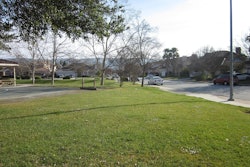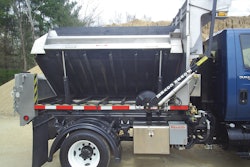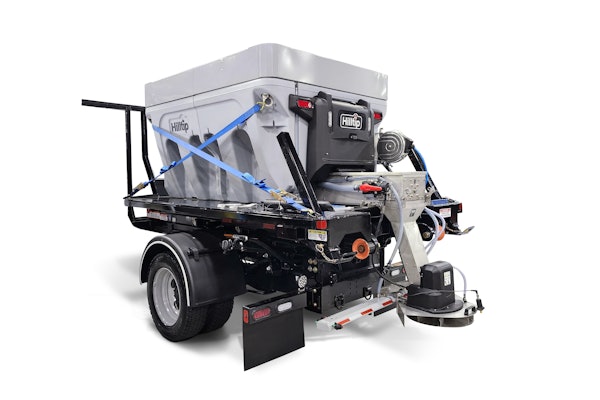 This xeriscape renovation replaced a bluegrass lawn with colorful perennials and shrubs.
This xeriscape renovation replaced a bluegrass lawn with colorful perennials and shrubs.Photo: Matrix Gardens
If you don’t live in the desert or often drought-stricken West, “xeriscaping” may be a term you’ve heard but know little about. Isn’t that a landscape of rocks and cacti?
Not exactly.
“Xeriscaping means you’re conserving water,” says Bodie Pennisi, a professor and extension landscape specialist at the University of Georgia. “We’re talking about beautiful, healthy, functional landscapes that use little water, no matter where you live.”
The term “xeriscaping” was coined in the ’80s by a task force that included representatives from Denver Water and the Associated Landscape Contractors of Colorado (ALCC).
“Back then,” says Mark Cassalia, conservation specialist with Denver Water, “most landscapes were primarily turf. The idea was to create an alternative. Today, the term focuses more on how a landscape is going to be used. It’s a process for creating water-efficient landscapes that people enjoy.”
As water becomes more precious and costly, it’s essential to understand that no place is immune to drought. Even areas that get sufficient rainfall have dry spells.
“When an area gets a certain amount of rainfall annually, it doesn’t come evenly spaced out each week,” says Georgia’s Pennisi. “Every place, even the tropics, has dry periods.” Planning ahead by using good design and installing drought-tolerant plants means your landscapes will be more likely to look good (and survive) even in stressful conditions.
By tweaking design and cultural practices, you can create landscapes that save clients money and set you apart from competitors. Here’s how to apply water-wise concepts to both new and existing landscapes:
Explain how changes save money
When renovating, talk about how water-wise improvements will benefit customers. “Clients don’t do things because you tell them ‘it’s the right thing to do.’ Help them make behavioral changes by illustrating how it affects them in the long run,” says Carole Kastler, landscape designer and consultant with Camelot Design in Denver and a member of the ALCC Sustainable Landscape Partners task force. “Saving water helps their pocketbooks. Explain what you’re proposing as a value-added service.”
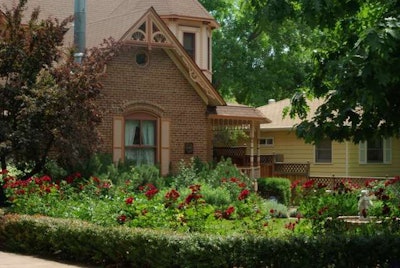 Photo: Matrix Gardens
Photo: Matrix GardensFocus on good design
Divide the landscape into zones. “Put the water where it provides the most benefit,” says James Coffman, landscape architect and president of Coffman Studio in Tempe, Arizona. “Create microclimates within your overall plan.” Group plants that have similar water needs together for efficient irrigation. Put ornamentals and turf closer to the home, where they can be enjoyed, and place more drought tolerant plants farther away from the house.
Prep the soil
Healthy soil is essential for healthy plants. Have soil a test done by your county extension office. “Clay soil holds water but is not good structure under drought when plant roots cannot penetrate because it becomes like terra cotta,” says Pennisi. On the other hand, sandy soil consists of large grains that allow water to drain too quickly before roots absorb it. Working organic matter in provides nutrients and helps the soil retain water better so plants use it efficiently.
Tune up irrigation
Existing systems often have leaks, heads that get clogged or sprayers that water the street. “Offer annual maintenance programs,” says Fred Kapp, education director for the Green Industry Web Portal, a green industry educational site. “Repairs and upgrades, such as replacing outdated meters and heads, are a tremendous business opportunity.” Install more efficient drip irrigation when possible and teach clients to water properly – infrequently, deeply and in the morning to reduce evaporation.
Always use mulch
Mulches prevent water evaporation, keep soil temperatures from fluctuating and prevent weed seeds from germinating, says Pennisi. Sell your clients on the necessity and practicality of mulch. Pea gravel, cobblestones, wood mulch, bark chips and pine straw are commonplace in different regions. “There’s no such thing as bad mulch. Any mulch is better than no mulch,” says Pennisi.
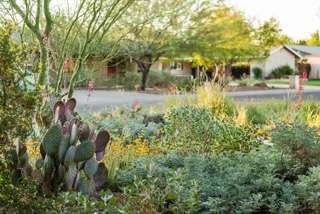 Photo: Coffman Studio (Leland Gebhardt Photography)
Photo: Coffman Studio (Leland Gebhardt Photography)Select the right plants
Native plants, which are adapted to a region’s soil, temperatures, and rainfall, are good choices for xeric landscapes. Expand your plant palette to include natives, as well as hardy cultivar selections. “Many cultivars have been developed to enhance disease and pest resistance, as well as to have improved bloom time,” says Nicholas Staddon, director of new plant introductions at Monrovia Growers. “But keep in mind that the most crucial point is choosing the right plant for the right spot.”
Think about turf
“Lawn has a place,” says Alison Peck, owner of Matrix Gardens in Boulder, Colorado, and another ALCC member. “But it’s not the only choice, so create practical turf areas that make sense.” Avoid using turf as groundcover or because you don’t know what else to plant. Enlarge existing beds for trees and foundation plantings. Convert unusable grass strips, such as along streets, to beds or plant more drought-resistant varieties. Look for areas where turf can be replaced with other plants, such as under trees, where it probably isn’t thriving anyway.
Reduce maintenance
Proper design reduces maintenance. “Choose less maintenance-heavy plants,” says Coffman. “For example, look for plants with an attractive shape that only reach a certain height so you won’t need to be out there shearing them multiple times a year.” Other commonsense steps include applying fertilizer less frequently, letting clippings fall back into the lawn when mowing and using proper pruning techniques to ensure healthy tree structure.
Look for opportunities
Talk to clients. Do they entertain frequently? Install an outdoor kitchen. Do they like to cook? Plant an edible garden. “There should be a consciousness about creating an outdoor living space clients will use and love,” says Mike Ransom, construction division manager with Lifescape Associates in Denver. “A patio with beautiful containers is about as low water-need and low-maintenance as it gets. We may not call it xeriscape, but we apply xeriscape to every project we install.”
Keep educating yourself
“By staying current, you become an industry leader and create a market niche,” says Kastler. Get involved in your state’s professional landscape association. Attend trade shows and conferences. Check out webinars like these offered by universities, your local county extension service, and educational portals. Don’t neglect employee training; lead classes and show videos so everyone learns water-wise concepts.


